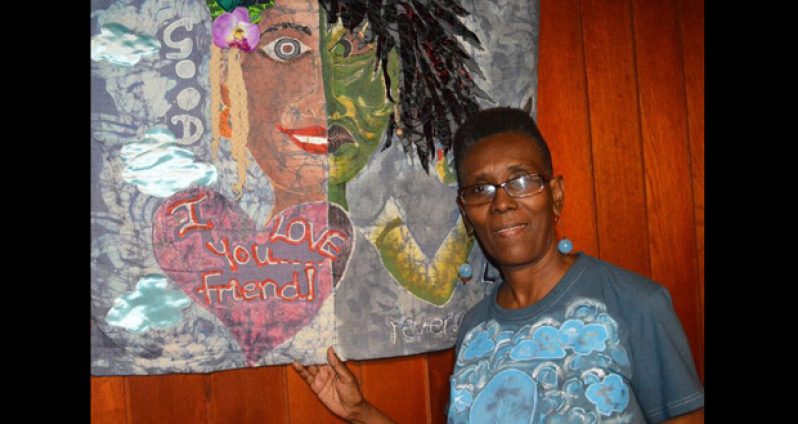By Dominique Hunter
There is a certain element of spontaneity that reveals itself in the meticulously designed batik works by Jennifer Gibson. It sounds a bit absurd having those two words in the same sentence, but everything begins to make sense once you’ve had the opportunity to view her beautiful textile art.

Initial feelings of awe only give way to questions of how. Your eyes anxiously scan across the lengths of fabric in a desperate attempt to understand the process. Your brain begins to imagine countless placement possibilities, which element came first and how everything else followed subsequently. After a few failed attempts, you accept defeat and resign yourself to simply marveling at the intricate beauty found in every square inch. And there is something rather delightful in knowing that no two sections of her batik works are exactly the same. Each time the work is viewed there is always something new to marvel at, some new detail you would’ve missed previously.
The word “batik” is believed to be an Indonesian-Malay word, used to describe a centuries-old type of resist method in which hot wax is brushed onto fabric to block out a particular design. Fabric dye is then applied to the exposed areas where the wax functions as a barrier, preventing neighbouring colours from bleeding into each other. This process is repeated until the desired aesthetic is achieved, after which the wax is removed through a series of boiling processes.

Fast-forward to 20th century Barbados and a young Jennifer Gibson is stuck in an unfulfilling job that she has often contemplated leaving. As fate would have it, she stumbled upon an opening in a local textile company and decided to go in for an interview. The very next day an eager Gibson would begin her journey into a medium that would transform both the production of her work and the course of her life in ways she couldn’t begin to fathom.
It was through the hands-on job training at the Barbados Batik (Export) Limited that Gibson was first introduced to this ancient textile technique. For more than three years she worked studiously, absorbing everything with a sponge-like quality and producing outstanding pieces that reflected her constant growth as a textile artist. Soon enough she outgrew that environment and decided to start her own batik business with two other women. However, internal conflicts among the business partners forced them to dissolve the company. She continued on her own by participating in various expos and craft shows across the region (Antigua, Guyana, St. Lucia, and Jamaica). But after things got difficult in Barbados, Gibson decided that she needed a break from the environment that grew so familiar to her.
In 1996, through the encouragement of her sister, she booked a flight to Guyana with the hope that it would inspire a different outlook. “When I came here [Guyana] I felt so motivated. I saw that Guyanese turned everything into a business. I never felt that way in my life. I never wanted to live anywhere outside of Barbados like I did Guyana. I just wanted to be here.”
After her initial visit Gibson was back and forth between Barbados and Guyana for quite a while before eventually deciding to stay in Guyana permanently. Her decision to move was met with resistance and concern from family members who couldn’t understand why she chose to move. But to this she simply remarked, “I know God wanted me here [in Guyana] and this is not something I’m just saying. This is something I’ve proven. I felt like I needed to be in Guyana to help empower the people, especially the women. I came here with all my plans to start a business and I did just that.”
Gibson described an emotional experience she had one Sunday in church after viewing a PowerPoint presentation by a pastor and his wife about the sanctuary they managed on the Linden Soesdyke Highway. “I just started crying and I heard this voice say, ‘You have to go and help these people.’” While it seemed like a directive from fate once again, Gibson admitted that she delayed acting on those “instructions” until she noticed her business began to suffer. She immediately took this as a cue to start, by volunteering a few days a week at the sanctuary. Over time she graduated from an unpaid volunteer to a paid employee with increased working days. For almost seven years she worked along with the children there, sharing her knowledge of textile art. But now she is gradually being released from her duties there since the current children are much too young to be taught batik techniques.
Like most creative practitioners living and working in Guyana, she has encountered her fair share of challenges during her years of practice. At the top of the list is perhaps Guyana’s lack of copyright laws. Gibson stated that this was a strange and uncomfortable experience for her since there were laws that protected artists in Barbados. Other roadblocks she encountered along the way included sourcing good quality art supplies (paints, dyes, fabrics etc.); finding trustworthy employees who were committed to producing high quality work; finding customers who were willing to pay for her work; constantly being undermined by persons working in the same field as her; and finding a male companion who understood the needs of an independent and creative woman who is passionate about her work.
Despite the many challenges Gibson remains excited about the future, describing 2016 as her year to “birth” the ideas she has been carrying for so long. She is currently in the process of setting up a studio in McDoom. Although the space is just big enough to accommodate her own creative production, she envisions expanding to an even bigger space in order to facilitate workshops where she hopes to impart her skills to as many people as possible. With a bright and hopeful smile she exclaims, “Things are going much better than I anticipated!”



.jpg)











